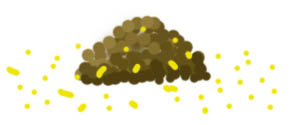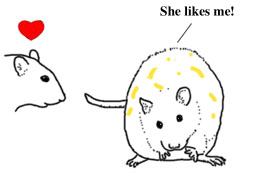- Why do some rats leave drops of pee everywhere?
- Why do rats pee on food?
- Why do rats pee on each other?
- Conclusion
Why do some rats leave drops of pee everywhere?
It's a personal ad
Adult male and female rats leave drops of pee everywhere to advertise their sexual availability. Pee contains a lot of information about the rat who made it! It's like a personal resumé. It tells another rat one's species, sex, age, social status, reproductive status, and individual.
Here's what a urine mark tells another rat:
|
|
Hot, healthy adult alpha male rat seeks any female rat. I'm a high testosterone, high fecundity guy! Let me father your offspring! (pee is two days old) |
|
|
Beta male rat seeks any female rat. I've lost a lot of fights recently, so my testosterone is kinda low, and I have a tapeworm, but I'd still loooove to meet you! (pee is five days old) |
|
|
Sexy female rat seeks handsome, experienced, dominant male to sire next litter. I'm gonna be in heat tomorrow, so hurry! (pee is fifteen minutes old) |
Adult males, especially socially dominant ones, mark the most. Males mark even more when they smell a female nearby! Male marking is influenced by testosterone: neutered rats mark less than intact rats.
Females mark less than males. Females do most of their marking the night before they go into heat (every 4 days). Females also mark more when they can smell other rats nearby, and females prefer the urine marks of high-testosterone males.
This smells like me!
But attracting rats of the opposite sex isn't the only reason rats mark. Rats use their own urine marks too.
Rats mark because they like things to smell like them. Having lots of personal smell around may comfort them. It may help them become familiar with an area.
Rats mark in response to novelty, too. Put a new object in a rat's cage and chances are, the rat will mark it. They also mark more when they smell something new to them, like a strange rat, or a cat, or mint.
Rats may also mark because it helps them know where they are and where they've been. Rats will re-mark an object that has been moved to a new spot.
Rats are also capable of following the odor trails they have left through the environment.

So, when a rat smells this, he knows: this smells like me, I like that. I've been here before. I'm comfortable here.
Isn't urine marking territorial?
It is common to think that when a mammal scent marks, it's marking its territory. This means that the urine plays a role in territorial defense: the urine is supposed to deter others of the same species from entering that space.
However, most claims of territorial marking have little or no empirical support in most species. In rats, the evidence is mixed: some studies find that male urine deters other males, other studies have found that male urine attracts other males. Therefore, it is as yet unclear whether urine marking in rats has a territorial function or not.
Why do rats pee on food?
Rats pee on food too. But before you grimace, remember the challenge rats face when deciding what to eat. Rats live all over the globe, and they are capable of eating a large variety of foods, from vegetables to grains to meat to twinkies. This ability to eat all sorts of stuff is different from, say, the panda bear which eats only bamboo, or the koala which eats only eucalyptus.
How on earth is a rat supposed to know what to eat? Mistakes can be fatal! Eat a toxic leaf or poison bait, and the rat is toast. Rats also have to be really, really careful about what they put down there, because they can't vomit.
Rats use a wide varity of strategies to choose what to eat. For one, they tend to take just a tiny taste of a new food, and if it makes them sick they strictly avoid that food afterwards. Another strategy they use is to learn from other rats. If another rat ate something, it's probably safe. So baby rats prefer to eat foods they taste in their mother's milk. Young rats prefer to eat foods they smell on each other's breath.
Rats also prefer to eat at food sites where other rats have eaten. These food sites are marked with a chemical attractant in the urine. Rats who eat food that turns out to be safe mark the area with a chemical attractant. Young rats prefer to eat at those sites. This attraction to urine at food sites is particularly strong in young rats. It wanes as they grow older.
|
|
|
All clear! A young rat who finds this pile of food will know it's probably safe, because it's surrounded by attractive urine marks. |
Rats do not, however, appear to mark bad or poisonous foods with an aversive signal that keeps other rats away.
Why do rats pee on each other?
Female marks a male: I like you!
Female rats tend to mark the males they like with more urine than males they don't like. Females typically like the most aggressive males who have high levels of testosterone. Such males may make better mates, because they're more fecund and successful than nonaggressive, low-testosterone males.
As with environmental marking, the female marks males most when she isn't in heat. It is possible that she may be picking out and notifying the males she likes best in advance, so when she comes into heat a few days later, her own urine marks will help her pick which males to mate with. This hypothesis has not yet been tested, however.
|
|
Males mark females, too
Males mark all females at high rates, regardless of whether the females are in heat or not. The function of such urine marking is unknown, but there are many possibilities. As with environmental urine marking, it could be a sexual advertisement ("I'm available! Mate with me!").
Juveniles mark adults, and vice versa!
Juveniles don't start marking their environment until they enter puberty, but they start marking other rats much earlier! One month old males copiously mark adult males, who copiously mark them right back. Juvenile and adult females urine mark each other too, at low rates that don't change with age.
As the young male rats approach puberty, they mark adult males less and less. This decline might happen because tension social tension is growing between the adolescent and the adult male. As tension grows, the young rat is less likely to climb over the adult, so he has less opportunity to mark him.
The function of juvenile-adult marking has never been explored.
However, we do know that juvenile urine inhibits attack by adult males: adult rats dabbed with juvenile urine are attacked less than those dabbed with adult urine. So, a juvenile's urine on his own fur stops attack. It is possible that a juvenile that smears urine on an adult male may inhibit the male's attack, too. This is purely speculative, but it's an interesting possibility.
|
|
A young male scent mark might mean: "I'm a juvenile male rat. Don't attack me, I'm just a little kid!" |
Males mark other males, too
• The dominant rat marks subordinates
The socially dominant male marks subordinates about three times more than they mark him. This difference might be because alpha rats crawl over subordinates a lot more than the reverse. Therefore, subordinates don't have as much opportunity to crawl over the dominants and mark them.
• Subordinate rats mark the dominant rat and other subordinates
Subordinare rats urine mark too. They deposit equal amounts of urine on everybody: other subordinates and the dominant rat.
However, subordinates can't crawl over the dominant rat as freely as they crawl over their fellow subordinates. They make up for this by depositing twice as much urine on the dominant rat when they manage to crawl over him as they do when they crawl over a subordinate.
So, the subordinate rat marks other subordinates and the dominant rat with equal amounts of urine, but they deposit their urine on the dominant rat in half as many passes.
Conclusion
Urine marking has many meanings, depending on the rat who made the urine mark and on the rat who smells it. Marks are used as sexual advertisements, to attract rats of the opposite sex. A rat uses its own scent marks to maintain an odor field and help it navigate through the landscape. Adult rats mark safe food sites which young rats prefer.
Rats mark each other, too. Between males and females, such marking is probably sexual. Females tend to mark the males they like best.
Juveniles mark adults too. We don't know why, but it might help deter adult attack. Males mark other males: dominant males mark subordinates more than the reverse, but subordinates mark too. Subordinates mark both dominants and other subordinates. The function of male-male marking is unknown.
Therefore, urine marking doesn't mean the same thing every time. The chemical cues contained in urine vary intimately with the biology of the rat that produced the urine. So the meaning of a particular urine mark depends on the individual -- its age, sex, social status, and reproductive state. In addition, rats who smell a urine mark may glean a different message from it depending on who they are: a female in heat, a juvenile, and a subordinate male will all respond differently to, say, an adult male's urine.
If you liked this page and want to learn more, visit:
- Urine marking in Norway rats for more in-depth information and supporting references.

